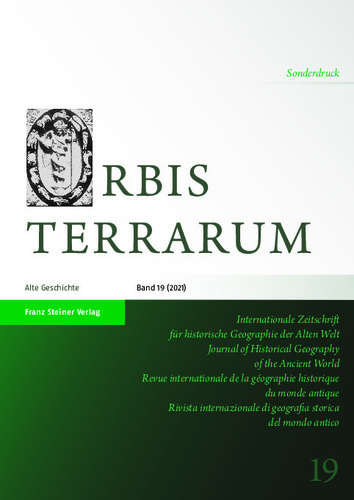| dc.contributor.author | Coskun, Altay | |
| dc.date.accessioned | 2023-05-03 14:56:37 (GMT) | |
| dc.date.available | 2023-05-03 14:56:37 (GMT) | |
| dc.date.issued | 2021-08-01 | |
| dc.identifier.uri | http://hdl.handle.net/10012/19403 | |
| dc.description.abstract | The Roman-Seleukid War (192–188 BC) resulted in the reorganization of Asia Minor, as sealed by the Treaty of Apameia. Its basic conditions are well known: Antiochus III withdrew from the areas north of the Taurus Mountains and additionally from Lycia, Pisidia and Pamphylia. However, the fate of the mountain landscape, later called Rough or Rugged Kilikia, is unclear, as well as the underlying spatial conception of the Romans. This is mainly due to the incomplete tradition of Polybios’ Histories (21.43.4–6, 14) as well as to uncertainties regarding Livy’s account, in particular 38.38.4: Excedito urbibus agris uicis castellis cis Taurum montem usque ad Tanain amnem, et ea ualle Tauri usque ad iuga, qua in Lycaoniam uergit. A revision of the sources shows that the traditional reading Tanain is to be adhered to instead of the conjectured Halyn and further that this name actually meant to denote the Don River. More information is provided by the shipping clauses (Polybios 21.43.14; Livy 38.38.9): Polybios originally specified the (middle?) Kalykadnos River as the new western boundary of the Seleukid Empire. However, Antiochus was still left with the floodplain west of the estuary (with Seleukeia), while being deprived of a strip adjacent to Lycaonia, located north of the same river. In contrast, the new demarcation in Eastern Anatolia remained vague, but not without repercussions either, giving way to the expansion of Pontos and other dynasties upon which the Seleukids lost their grip. | en |
| dc.language.iso | de | en |
| dc.publisher | Steiner Verlag, Stuttgart, Germany | en |
| dc.relation.ispartofseries | Orbis Terrarum;19 | |
| dc.relation.uri | http://www.altaycoskun.com/map-black-sea-12 | en |
| dc.relation.uri | http://www.altaycoskun.com/map-black-sea-13 | en |
| dc.subject | Peace of Apameia | en |
| dc.subject | Seleukids | en |
| dc.subject | Kilikia | en |
| dc.subject | Taurus / Tauros | en |
| dc.subject | Tanais / Don | en |
| dc.subject | Kalykadnos / Göksu | en |
| dc.subject | Sarpedon(ion) / İncekum Burnu | en |
| dc.subject | Halys / Kızılırmak | en |
| dc.title | Die geopolitische Bedeutung der Flüsse Tanais und Kalykadnos in den Territorialklauseln des Friedensvertrags von Apameia (Liv. 38,38,4.9) | en |
| dc.title.alternative | (‘The Geopolitical Significance of the Rivers Tanais and Kalykadnos in the Territorial Clauses of the Peace Treaty of Apameia (Livy 38.38.4, 9)’) | en |
| dc.type | Article | en |
| dcterms.bibliographicCitation | Die geopolitische Bedeutung der Flüsse Tanais und Kalykadnos in den Territorialklauseln des Friedensvertrags von Apameia (Liv. 38,38,4.9), Orbis Terrarum 19, 2021, 89-113. | en |
| uws.contributor.affiliation1 | Faculty of Arts | en |
| uws.contributor.affiliation2 | Classical Studies | en |
| uws.typeOfResource | Text | en |
| uws.peerReviewStatus | Reviewed | en |
| uws.scholarLevel | Faculty | en |

